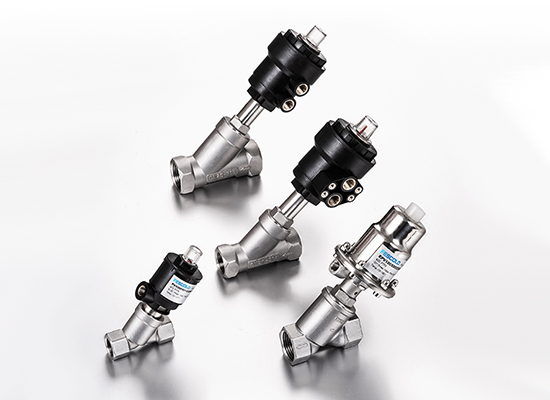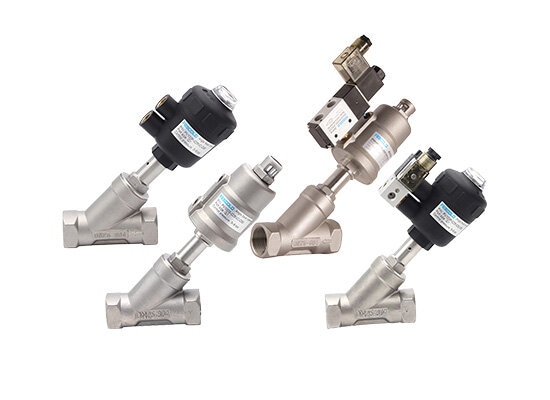What is angle seat valve?
The Angle Seat Valve is an automatically pneumatic controll valve primarily driven by compressed air actuator. It features an angle design, The most notable feature of angle seat valves is to use pneumatic piston to drive the valve core,with the valve body arranged at an inclined angle, making angle seat piston valve ideal for high-frequency and rapid switching operations.
The piston control valve offers smooth flow paths with low flow resistance, and is suitable for handling high-temperature, high-viscosity, or particle-laden media. Angle seat valve is known for their fast response, long service life, excellent sealing performance, and ease of maintenance and especailly widely used in automated industrial processes such as food processing, textiles, and packaging, playing a vital role in fluid on/off control and regulation, and are considered one of the key actuators in modern fluid control systems.
Advantages of Angle seat piston valve
Angle seat vlave is the angle formed by the fluid flow channel and the piston rod,this design make it has fast response speed and large flow rate, Unlike globe control valves that have slower response times and focus more on adjusting accuracy.So angle seat valve is suitable for applications with fast switching and high-frequency operation.
◆ High Flow Capacity:Angle seat valve has a very high flow capacity, making it a ideal for high-flow liquid, gas, or steam transmission,Because it is usually typically tilted at an angle of 45° or more, allowing fluid to pass through without making sharp 90-degree turns as seen in traditional straight valve seat.
◆ High Sealing Performance and Durability:Angle seat valve is typically equipped with high-performance sealing elements, ensuring reliable sealing even under extreme working conditions. This makes piston valve highly popular in applications where sealing performance is critical.
◆ Automation and Manual Operation Options:Angle seat valves can be configured with either an automated control system or manual operation. The automated versions use electric or pneumatic actuators to achieve precise flow control, making them suitable for applications that require real-time flow adjustments.
◆ High-Temperature and Corrosion-Resistant Materials:To meet the demands of different working environments, angle seat piston valves are usually made of Stainless steel, brass, plastic and other materials that are resistant to high temperatures and corrosion.
Function of angle seat piston valve
The main function of an Angle Seat Valve is to quickly and reliably control the on/off and direction of fluid flow.In addition, there are some other functions:
◆ Quick opening and closing
◆ High temperature and high-pressure medium control
◆ Prevent medium backflow
◆ Throttle and regulation function
◆ Realize system automation and remote control
Types of Angle Seat piston Valve
Angle seat valves can be classified from multiple perspectives, with common categories including the type of actuator, control mode, installation style, number of ports, and valve body material.
The Manual Angle Seat Valve is a type of angle seat valve operated by a handle or knob for opening and closing, offering more direct and simple control. It is typically designed with a two-way or three-way structure and is characterized by its cost-effectiveness, long service life, and wide applicability.
The Electric Angle Seat Valve is a type of angle seat valve that achieves automatic opening and closing through an electric actuator. It provides precise control and can be integrated with automation systems. It is typically available in two-way or three-way configurations. This valve offers convenient remote control, stable performance, and is suitable for applications requiring Precise control and intelligent integration.
The pneumatic angle seat valve is a type of angle seat valve that achieves automatic opening and closing through a pneumatic actuator. It features fast response and reliable performance, typically available in two-way or three-way configurations. It is mainly used in industries that prioritize quick response and high-frequency durability.
The valve seat angle mainly refers to the angle between the flow passage and the pipeline. Common angle types include 37°, 50°, with other options such as 60° and 75° also available. There are 2-way, 2-position angle seat valves, and internationally recognized brands such as SMC and Festo offer various models.
Application of Angle Seat Valve
The Angle Seat Valve is a type of automaticed control piston valve suitable for applications requiring high-frequency and rapid switching of fluids.
◆ Food and Beverage Industry
◆ Pharmaceutical and chemical industries
◆ Water treatment and environmental protection equipment
◆ Textile printing and dyeing industry
Angle seat piston valve working principle
Angle seat valve driven by many types include pneumatic,electric and manual.Pneumatic Angle Seat valve is mainly driven by pneumatic actuator;The electric driving method mainly relies on electric actuators to automatically control the opening and closing of valves;The manual driving method mainly involves the operator manually opening or closing the valve through handles, knobs.Regardless of the type of drive method, they all operate by using a linearly moving piston to directly actuate the valve plug, thereby achieving valve opening and closing.
Browse this article to obtain detail operation information about three driving methods for angle seat valves.Regular maintenance of angle seat valves is crucial for their long-lasting and effective operation.
FAQ
Q1:What is angle seat piston valve?
The actuation of an angle seat valve can be simply described as using a pilot valve to fill the actuator with compressed air, which drives the piston to move up and down, thereby lifting or pressing the valve plug against the seat.
Q2:How does pneumatic angle seat valve work?
A pneumatically operated angle seat valve operates by using air pressure to move piston, which in turn controls the opens or closes of the diameter of compressed air.
Q3:What are the advantages of using an angle seat valve?
Angle seat valves offer high durability, superior flow rates, and are suitable for harsh environments, making them more efficient than ball or solenoid valves.
Angle seat valve provided by Fokca
Fokcavalve is a pneumatic products factory which offers competitive angle seat valve prices compare peers without compromising on quality, making us a cost-effective choice for bulk procurement and OEM partnerships. Our products range includes pneumatic, manual, and customized angle seat valves, designed for fast switching, leak-proof operation, and easy maintenance.
Fokca's expertise extends beyond manufacturing—we help customers select the best angle seat valve for optimal flow control, efficiency, and system compatibility. Whether you need standard valves or industry-specific solutions, our team provides reliable support from selection to after-sales service.
Contact us today for your angle seat valve needs—where quality meets affordability!
















